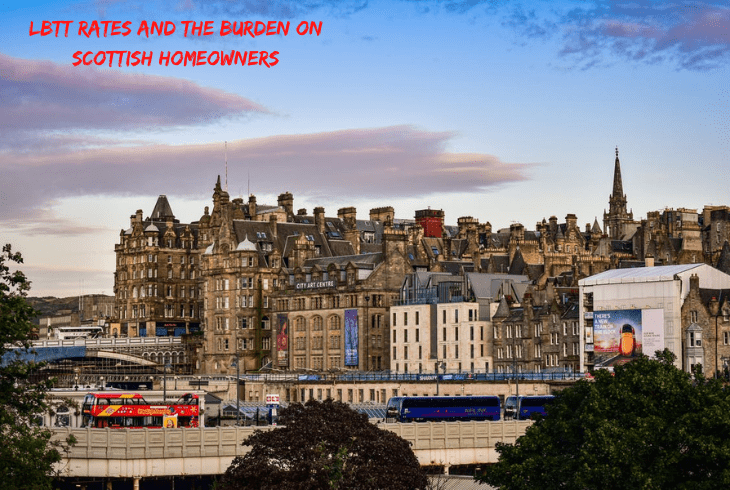Property trends in Scotland have differed greatly from England and Wales over the last decade, LBTT rates have disproportionately increased over and above SDLT (England/NI) and LTT (Wales). Scottish property owners have paid higher taxes than the rest of the UK while also enduring an ongoing shortage of affordable homes. In this article, we will take a look at some of the problems that are currently affecting the property development and housing markets in Scotland, and what is being done to rectify them.
The Rise in LBTT rates
In July 2020, Scotland saw an increase in the Land and Buildings Transaction Tax In comparison, from April 2019 to March 2020, the total of LBTT was £404.5m raised from 105,160 transactions, equalling £3,846 per property, while April 2020 to March 2021 saw an average of £3,760 per property.
From 2019-2020, LBTT rates in Scotland has increased by 36.3%.
The main reason for this is the significant rise in property prices in Scotland, combined with first-time buyers being eligible to pay stamp duty on properties that cost £145,001 or more. There is somewhat of a disparity for a first-time buyer buying a property in Scotland worth over £325,000. Taking a purchase of £330,000 a first-time buyer in England/NI will pay £1,500 SDLT of the property value or expressed as 0.5% of the property value. For a property with the same purchase price in Scotland a first-time buyer will pay £5,750 LBTT and/or expressed as 1.7% of the property value. Further figures can be confirmed with our LBTT Calculator.
In Edinburgh, for example, the average property price is £315,070, meaning many first-time buyers as well as being priced out face paying £4,250 more than house buyers across the border in England and Northern Ireland. Find out more about property sold prices Edinburgh and the rest of the UK. Notably The Scottish Government refused to extend the cut in LBTT rates (stamp duty holiday) from the end of March 2021. The Scottish finance secretary said the stamp duty holiday had “achieved” it’s aims of housing market recovery. While also citing that the 100% relief for non-domestic rates for Scottish businesses was extended.
The Housing Shortage
According to a report by the industry body, Homes for Scotland in March 2022, Scotland is short of 100,000 new homes, the result of more than a decade of consistent under supply. Because of this, Homes for Scotland are calling for 25,000 new homes to be constructed every year until supply matches demand.
In response, the Scottish government has now committed to the More Homes Scotland approach, introducing a framework to make it quicker and easier to plan new developments that meet the required standard. In addition, the initiative will also introduce a range of funding mechanisms that will enable the construction of more affordable housing across the country.
Funding mechanisms include:
- The Housing Infrastructure Fund
- The Rural and Islands Housing Funds
- The Building Scotland Fund
- Gypsy/ Traveller Accommodation Fund
- The Build-to-Rent scheme
- Government Grants and Loans
Tenement Problems
Tenement buildings across Scotland are falling into a state of disrepair and leaseholders and homeowners are being left to foot the bill. These unfortunate private owners must seek an arrangement with other flat owners within the building. However, many have discovered that the Scotland Landlord Register is out of date, turning it into a frustrating and gruelling process. Under the Tenement Scotland Act 2004, repair work can be carried out if most of the owners in the building agree to it. However, if some owners refuse to pay, then the shortfall has to be made up by everyone else.
As Scotland has focused on building more affordable housing, existing buildings have been somewhat neglected, with maintenance and repair work non-existent in some cases. The Scottish House Condition Survey found that 50% of Scottish housing is in a state of critical disrepair, with around half of these buildings requiring urgent attention.
The Housing Improvement Task Force (HITF), set up in 2000, has outlined a number of recommendations for the Scottish government. This resulted in the Tenements Act 2004 and the Housing Act 2006, although little has been done to improve the situation and for the most part, the conditions of Scottish tenements have continued to worsen as local authorities are reluctant to allocate their own resources.
One exception was in Glasgow in 2017 when the local council became the first in Scotland to be given the authority to create an Enhanced Enforcement Area (EEA) for Govanhill, as the situation became critical. In 2018, Govan Housing also upgraded 295 buildings that were built before 1919 in Cessnock and Ibrox.
Property Development in Scotland – Conclusion
It is clear that there are a number of challenges for developers, homeowners, local councils, and the government in Scotland, with a desperate need for new homes and urgent maintenance required for existing buildings.
Many funding mechanisms and legislations have been introduced to help rectify these issues but it is clear that the situation will not be remedied overnight. This does provide a great opportunity for developers, however, especially if they are interested in the affordable homes market.
Property prices in Scotland, particularly Edinburgh continue to soar, with Stamp Duty increasing by a third from 2019-2022, making owning your home a difficult task for many first-time buyers. It remains to be seen whether the market will begin to subside as the effects of the pandemic begin to wane and the UK enters the widely forecast recession. For clarity of any content and terminology please refer to our development loan development loan terms page here.

